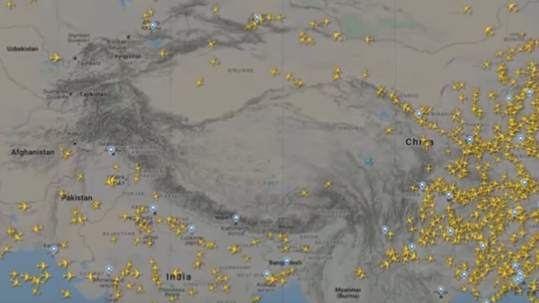If a location is a no-fly zone (a.k.a. no-flight zone [NFZ] or air exclusion zone [AEZ]), then, of course, no one will fly over it (unless, for some reason, air traffic control tells them to. ATC usually makes the final call).
Places undergoing local conflict (i.e. Russia and Ukraine right now) may be NFZs. So can locations that are of high security (i.e. Nevada’s Area 51).
However sometimes planes don’t fly over certain areas for different reasons.
- Although not areas of conflict or national security,Walt Disney World and Disneyland have been limited NFZ for years (several Congresspeople called for the end of Disney’s NFZs a while back. To date, it has not been rescinded).
- Planes generally don’t fly over the Pacific Ocean unless they have to (here’s why).
- For another reason entirely, United and Hawaiian make it their business to avoid flying over Mexico.
And then you have Tibet. An autonomous region of China, much of the area is sparsely populated, even though it spans about 970,000 square miles.
Tibet is on a high plateau, aptly named The Plateau of Tibet. And that plateau is surrounded by enormous mountains. The relatively level northern part of the plateau is called the Qiangtang; it extends more than 800 miles from west to east at an average elevation of 16,500 feet above sea level.
And that’s the start of why planes don’t fly over this large mountainous region of Tibet. This video explains:
So to summarize:
Although most plans fly between 30,000 and 35,000 feet above sea level, if the had an emergency and needed to descent to 10,000 due to, say, cabin depressurization or engine failure, they couldn’t…the mountains are too high (and yeah, oxygen masks could come down, but there’s only enough oxygen for 10 minutes or so – enough to get the plane to 10,000 feet).
On top of that, frankly, there’s little demand for flights to Tibet. Despite Tibet taking up almost 13% of China’s landmass, it only accounts for 0.2% of the country’s population.
There’s also more risk of turbulence over the area. Turbulence is caused by several factors, including temperature, weather, speed of air currents and, yep, mountains. Air current, of course, can’t go through mountains. It hits the solid walls of the range and has nowhere to go but up. So mountains cause the air currents above them to be much more of a potential aerial hazard.
And finally, temperatures on mountainous terrain tends to colder. Much colder. It’s a small risk, but there’s the potential for jet fuel to freeze when flying over such tall peaks for long periods of time.
So overall? Most planes don’t fly over Tibet because too much could go wrong. And if something went wrong, it’d be a super dangerous situation.
Want to comment on this post? Great! Read this first to help ensure it gets approved.
Want to sponsor a post, write something for Your Mileage May Vary, or put ads on our site? Click here for more info.
Like this post? Please share it! We have plenty more just like it and would love it if you decided to hang around and sign up to get emailed notifications of when we post.
Whether you’ve read our articles before or this is the first time you’re stopping by, we’re really glad you’re here and hope you come back to visit again!
This post first appeared on Your Mileage May Vary
Join our mailing list to receive the latest news and updates from our team.

